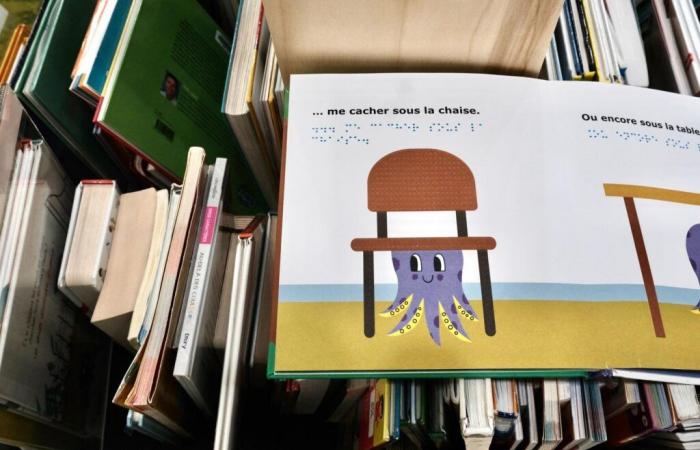In the hubbub that invades the book and youth press fair in Montreuil hides, aside, a space like no other. At its pink front door, we read “The Bubble”, as well as a few pictograms: a crossed eye, a symbol of visual problems, a character in a wheelchair, a sign of a motor disability. A duplicate face, finally, for mental disability.
In the small carpeted room, two boys in wheelchairs spend time reading, in the company of Stéphanie Bourguignon, actress and audio describer. “ I am the wolf! Aww! »she read with energy. Félix, 10 years old, and Abdoulaye, 13 years old, smile until their jaws drop. “ Abdoulaye loves being told stories, especially when it's well done! » says Valéry, a specialist educator. “In the Bubble, we discover a whole range of adapted literature”presents Stéphanie Bourguignon.
Autistic disorders, visual or hearing impairments, DYS disorders, motor disabilities… Everyone will find, here, a book designed for their disability, both in content and in form. “If the child is dyslexic, we have this book Easy to read and understand (FALC), in large print, with colored letters and spaced linesguide Stéphanie. If he is visually impaired, here are audio books, in Braille or tactile books. » His favorite: the album My flower herbariumpublished by the house Mes mains en or, in which it is possible to slide your fingers over flowers with soft, rough, plastic materials…
“Adapted” editors
But adapted literature does not stop at the Bubble. On the first floor, among the 400 exhibiting publishing houses, several sell this type of book. This is the case, for example, of Kiléma Éditionswhich offers 28 works. In the “teen” category, the famous Three Musketeers are stacked next to Sherlock Holmes. Theater side, Cyrano de Bergerac also has its adapted version, full of colors, instructions and explanations added in order to enlighten audiences whose understanding is more complicated.
At the stand opposite, The Hen That Lays presents works adapted to DYS disorders. In the comics, albums and short novels found here, the silent letters are underlined and the words are “syllabized”, that is to say colored according to their syllables. “ In this form, DYS children are better able to imprint words in their heads”explains Valentin Mathé, founder of the house and himself dyslexic. And it seems to work: “The investigations of Quentin and Sophiewe have already sold 10,000 copies! »smiles the editor.
Like ten other publishing houses, The Hen That Lays part of the collective Atypical editorsfounded a year ago. Its objective: to convince people of the importance of these books: “ Reading is a fundamental right. However, for those who are unable to attend, it is even more flouted than the othersinsists Cécile Arnoult, director of Kiléma Éditions, during a professional meeting on the theme of accessibility and inclusion. Having access to literature that they love means going beyond the limits of disability for them. »
Lack of visibility
For Valentin Mathé, the creation of the collective is a sign of the rise in power of adapted publishing: “ It's happening, the sector is becoming structured. Even the big publishing houses are starting to create adapted books”he testifies. This is the case, for example, of the digital collection “I like reading dys” designed in 2018 by Bayard Jeunesse (owned by the publishing group of The Cross). « Thanks to the digital format, the child chooses for himself whether he wants visual cues, definitions, a particular font, etc. », Lists Dimitri Chambon, formerly responsible for digital books. Thus, it is clear that “ the adapted book is part of current editorial concerns among young people, supports Sylvie Vassallo, director of the Salon de Montreuil. But don't always find enough visibility. »
The sector is, in fact, facing certain obstacles. Starting with the price of the works, which cost more than the others, between €20 and €26 each for example at A dilemma. In question: “ There are more colors, illustrations, the paper is thicker to avoid transparencyexplains Louise Mailloux, editorial manager. And, we choose to hire people with disabilities for proofreading, which adds to production costs. »
Despite these difficulties, adapted publishers do not lose hope: “ It's a social subject that goes well beyond the book, says Cécile Arnoult, mother of a child with Down syndrome. What really matters is whether we want to continue to exclude part of the population, or whether we want to open them up to the world? » A sign, once again, that children's books catalyze questions much broader than just the number of its pages.






